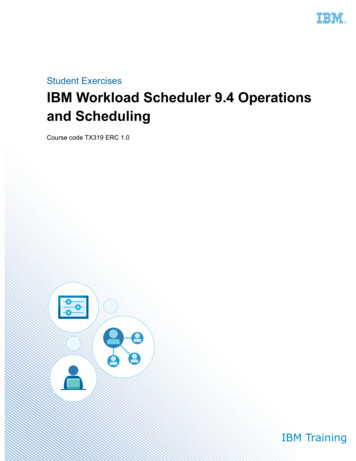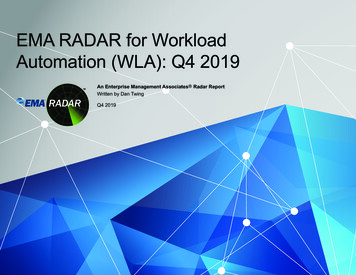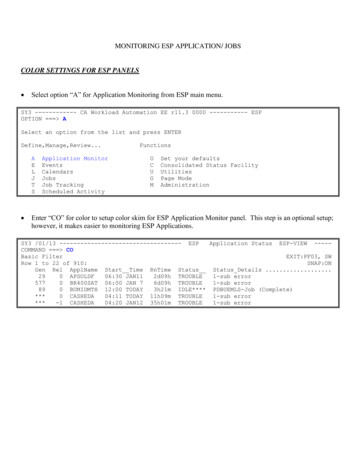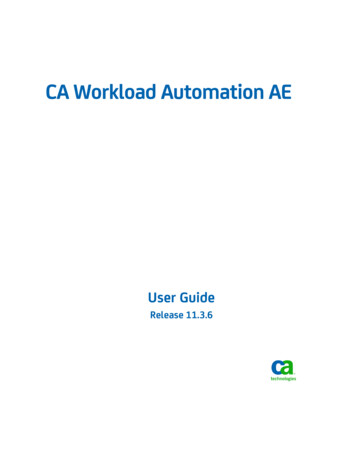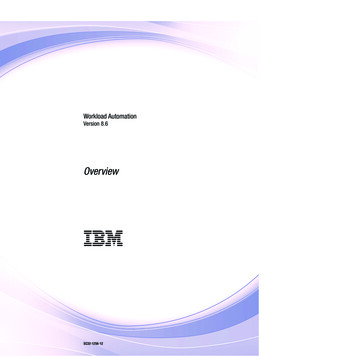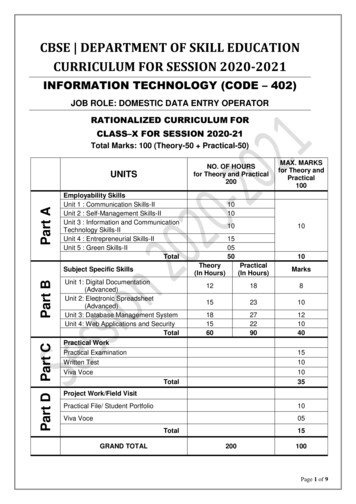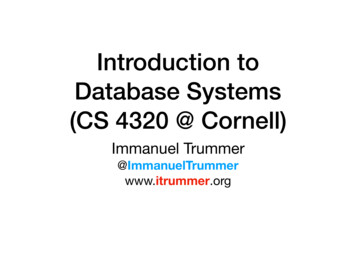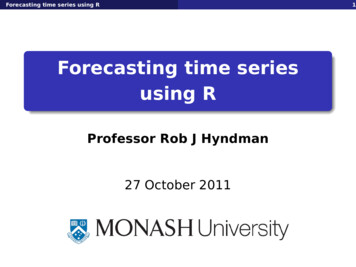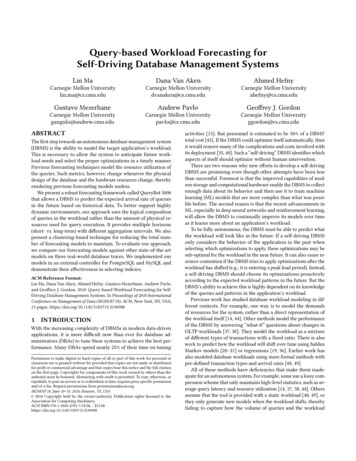
Transcription
Query-based Workload Forecasting forSelf-Driving Database Management SystemsLin MaDana Van AkenAhmed HefnyCarnegie Mellon Universitylin.ma@cs.cmu.eduCarnegie Mellon Universitydvanaken@cs.cmu.eduCarnegie Mellon Universityahefny@cs.cmu.eduGustavo MezerhaneAndrew PavloGeoffrey J. GordonCarnegie Mellon Universitygangulo@andrew.cmu.eduCarnegie Mellon Universitypavlo@cs.cmu.eduCarnegie Mellon Universityggordon@cs.cmu.eduABSTRACTThe first step towards an autonomous database management system(DBMS) is the ability to model the target application’s workload.This is necessary to allow the system to anticipate future workload needs and select the proper optimizations in a timely manner.Previous forecasting techniques model the resource utilization ofthe queries. Such metrics, however, change whenever the physicaldesign of the database and the hardware resources change, therebyrendering previous forecasting models useless.We present a robust forecasting framework called QueryBot 5000that allows a DBMS to predict the expected arrival rate of queriesin the future based on historical data. To better support highlydynamic environments, our approach uses the logical compositionof queries in the workload rather than the amount of physical resources used for query execution. It provides multiple horizons(short- vs. long-term) with different aggregation intervals. We alsopresent a clustering-based technique for reducing the total number of forecasting models to maintain. To evaluate our approach,we compare our forecasting models against other state-of-the-artmodels on three real-world database traces. We implemented ourmodels in an external controller for PostgreSQL and MySQL anddemonstrate their effectiveness in selecting indexes.ACM Reference Format:Lin Ma, Dana Van Aken, Ahmed Hefny, Gustavo Mezerhane, Andrew Pavlo,and Geoffrey J. Gordon. 2018. Query-based Workload Forecasting for SelfDriving Database Management Systems. In Proceedings of 2018 InternationalConference on Management of Data (SIGMOD’18). ACM, New York, NY, USA,15 pages. ONWith the increasing complexity of DBMSs in modern data-drivenapplications, it is more difficult now than ever for database administrators (DBAs) to tune these systems to achieve the best performance. Many DBAs spend nearly 25% of their time on tuningPermission to make digital or hard copies of all or part of this work for personal orclassroom use is granted without fee provided that copies are not made or distributedfor profit or commercial advantage and that copies bear this notice and the full citationon the first page. Copyrights for components of this work owned by others than theauthor(s) must be honored. Abstracting with credit is permitted. To copy otherwise, orrepublish, to post on servers or to redistribute to lists, requires prior specific permissionand/or a fee. Request permissions from permissions@acm.org.SIGMOD’18, June 10–15, 2018, Houston, TX, USA 2018 Copyright held by the owner/author(s). Publication rights licensed to theAssociation for Computing Machinery.ACM ISBN 978-1-4503-4703-7/18/06. . . ties [15]. But personnel is estimated to be 50% of a DBMS’total cost [45]. If the DBMS could optimize itself automatically, thenit would remove many of the complications and costs involved withits deployment [35, 40]. Such a “self-driving” DBMS identifies whichaspects of itself should optimize without human intervention.There are two reasons why new efforts to develop a self-drivingDBMS are promising even though other attempts have been lessthan successful. Foremost is that the improved capabilities of modern storage and computational hardware enable the DBMS to collectenough data about its behavior and then use it to train machinelearning (ML) models that are more complex than what was possible before. The second reason is that the recent advancements inML, especially in deep neural networks and reinforcement learning,will allow the DBMS to continually improve its models over timeas it learns more about an application’s workload.To be fully autonomous, the DBMS must be able to predict whatthe workload will look like in the future. If a self-driving DBMSonly considers the behavior of the application in the past whenselecting which optimizations to apply, these optimizations may besub-optimal for the workload in the near future. It can also cause resource contention if the DBMS tries to apply optimizations after theworkload has shifted (e.g., it is entering a peak load period). Instead,a self-driving DBMS should choose its optimizations proactivelyaccording to the expected workload patterns in the future. But theDBMS’s ability to achieve this is highly dependent on its knowledgeof the queries and patterns in the application’s workload.Previous work has studied database workload modeling in different contexts. For example, one way is to model the demandsof resources for the system, rather than a direct representation ofthe workload itself [14, 44]. Other methods model the performanceof the DBMS by answering “what-if” questions about changes inOLTP workloads [37, 38]. They model the workload as a mixtureof different types of transactions with a fixed ratio. There is alsowork to predict how the workload will shift over time using hiddenMarkov models [28–31] or regressions [19, 36]. Earlier work hasalso modeled database workloads using more formal methods withpre-defined transaction types and arrival rates [48, 49].All of these methods have deficiencies that make them inadequate for an autonomous system. For example, some use a lossy compression scheme that only maintains high-level statistics, such as average query latency and resource utilization [14, 37, 38, 44]. Othersassume that the tool is provided with a static workload [48, 49], orthey only generate new models when the workload shifts, therebyfailing to capture how the volume of queries and the workload
BusTrackerMOOCMySQL2165075M2541M [99.8%]1.8M [0.07%]2.6M [0.1%]0.4M [0.02%]PostgreSQL955819.9M19.5M [98%]15K [0.8%]22K [1%]3K [0.2%]MySQL454851.1M0.97M [88%]14K [1.3%]66K [6%]51K [4.7%]Table 1: Sample Workloads – Summarization of the workload tracescollected from the database applications described in Section 2.1.trends change over time [19, 36, 48, 49]. Lastly, some models arehardware and/or database design dependent [28–31], which meansthe DBMS has to retrain them whenever its configuration changes.In this paper, we present a method to succinctly forecast theworkload for self-driving DBMSs. Our approach continuously clusters queries based on the their arrival rate temporal patterns. Itseamlessly handles different workload patterns and shifts. It thenbuilds models to predict the future arrival patterns for the queryclusters. Such predictions are necessary to enable an autonomousDBMS’s planning module to identify optimizations to improve thesystem’s performance and apply them proactively [40]. The key advantage of our approach over previous forecasting methods is thatthe data we use to train our models is independent of the hardwareand the database design. Thus, it is not necessary to rebuild themodels if the DBMS’s hardware or configuration settings change.To evaluate our forecasting models, we integrated this framework into both MySQL [1] and PostgreSQL [5], and measure itsability to model and optimize three real-world database applications. The results demonstrate that our framework can efficientlyforecast the expected future workload with only a minimal loss inaccuracy. They also show how a self-driving DBMS can use thisframework to improve the system’s performance.The remainder of this paper is organized as follows. Section 2discusses common workload patterns in database applications. Wenext give an overview of our approach in Section 3 and then presentthe details of its components: Pre-Processor (Section 4), Clusterer(Section 5), and Forecaster (Section 6). We provide an analysis of ourmethods in Section 7 and conclude with related work in Section 8.2BACKGROUNDThe goal of workload forecasting in an autonomous DBMS is toenable the system to predict what an application’s workload willlook like in the future. This is necessary because the workloads forreal-world applications are never static. The system can then selectthe optimizations to prepare based on this prediction.We contend that there are two facets of modern database applications that make robust, unsupervised workload forecastingchallenging. The first is that an application’s queries may havevastly different arrival rates. Thus, an effective forecasting modelmust be able to identify and characterize each of these arrival ratepatterns. The second is that the composition and volume of thequeries in an application’s workload change over time. If the workload deviates too much from the past, then the forecasting modelsbecome inaccurate and must be recomputed.We now investigate the common characteristics and patternsin today’s database applications in more detail. We begin with anintroduction of the three real-world database application traces300200100000:00Queries / mAdmissions1.8 1012:0000:0012:0000:00(a) Cycles (BusTracker)12:0000:0051.20.60.0Dec 09Dec 11Dec 12(b) GrowthUnique QueriesDBMS TypeNum of TablesTrace Length (Days)Avg. Queries Per DayNum of SELECT QueriesNum of INSERT QueriesNum of UPDATE QueriesNum of DELETE QueriesL. Ma et al.Queries / mSIGMOD’18, June 10–15, 2018, Houston, TX, USADec 14DeadlineDec 15and Spikes (Admissions)9006003000New ReleaseMay 16May 31Jun 15Jun 30Jul 15(c) WorkloadEvolution (MOOC)Figure 1: Workload Patterns – Examples of three common workloadpatterns in database applications.used in our discussions and experiments, followed by an overviewof the common patterns that these traces exhibit. We then discussthe challenges that effective forecasting models must overcome.2.1Sample WorkloadsWe now give a high-level description of the three sample workloadtraces collected from real-world database applications. Table 1 provides a more detailed summary of their properties.Admissions: An admissions website for a university’s graduateprogram. Students submit their application materials to programsin different departments. Faculties review the applications after thedeadline and give their decisions.BusTracker: A mobile phone application for live-tracking of thepublic transit bus system. It ingests bus location information atregular intervals from the transit system, and then helps users findnearby bus stops and get route information.MOOC: A web application that offers on-line courses to peoplewho want to learn or teach [3]. Instructors can upload their coursematerials, and students can check out the course content and submittheir course assignments.2.2Workload PatternsWe now describe the three common workload patterns prevalent intoday’s database applications. The first two patterns are examplesof different arrival rates that the queries in database applicationscan have. The third pattern exhibits how the composition of thequeries in the workload can change over time.Cycles: Many applications are designed to interact with humans,and as such, their workloads follow cyclic patterns. For example,some applications execute more queries at specific ranges of a daythan at others because this is when people are awake and usingthe service. Figure 1a shows the number of queries executed perminute by the BusTracker application over a 72-hour period. TheDBMS executes more queries in the daytime, especially during themorning and afternoon rush hours since this is when people aretaking buses to and from work. This cycle repeats every 24 hours.
Query-based Workload Forecasting forSelf-Driving Database Management SystemsNot all applications have such peaks at the same time each day, andthe cycles may be shorter or longer than this example.Growth and Spikes: Another common workload pattern iswhen the query volume increases over time. This pattern is typicalin start-ups with applications that become more popular and inapplications with events that have specific due dates. The Admissionsapplication has this pattern. Figure 1b shows the number of queriesper minute executed over a week-long period leading up to theapplication deadline. The arrival rate of queries increases as thedate gets closer: It grows slowly at the start of the week but thenincreases rapidly for the final two days before the deadline.Workload Evolution: Database workloads evolve over time.Sometimes this is a result of changes in the arrival rate patterns ofexisting queries (e.g., new users located in different time zones startusing an application). The other reason this happens is that thequeries can also change (e.g., new application features). Of our threeapplications, MOOC incurs the most changes in its workload mixture. Figure 1c shows the accumulated number of distinct queriesthat the MOOC application executes over time. The graph showsthat there is a large shift in the workload after the organizationreleased a new feature in their application in early May.2.3DiscussionThere are three challenges that one must solve for a forecastingframework to work in real-world DBMS deployments. Foremostis that in order to exploit the various arrival rate patterns in theworkloads for optimization planning, there is a need for good arrival rate forecasting models. Not only do different workloads havedifferent patterns, but a single workload can also have separatepatterns for sub-groups of queries. Thus, an effective forecastingmodel must be able to identify and characterize patterns that areoccurring simultaneously within the same workload.The second challenge is that since applications execute millionsof queries per day, it is not feasible to build forecasting models foreach query in the workload. This means that the framework mustreduce the complexity of the workload that it analyzes withoutseverely reducing the accuracy of its predictions.Lastly, the framework must handle the changes in the workload’spatterns as well as the query mixtures. All of this must be donewithout any human intervention. That is, the framework cannotrequire for a DBA to tune its internal parameters or provide hintsabout what the application’s workload is and when it changes.3QUERYBOT 5000 OVERVIEWThe QueryBot 5000 (QB5000) is a workload forecasting frameworkthat runs as either an external controller or as an embedded module.The target DBMS connects to the framework and forwards all thequeries that applications execute on it. Decoupling the frameworkfrom the DBMS allows the DBA to deploy it on separate hardwareresources. Forwarding the queries to QB5000 is a lightweight operation and is not on the query executor’s critical path. As QB5000receives these queries, it stores them in its internal database. It thentrains models that predict which types of queries and how many ofthem the DBMS is expected to execute in the future. A self-drivingSIGMOD’18, June 10–15, 2018, Houston, TX, USADBMS can then use this information to deploy optimizations thatwill improve its target objective (e.g., latency, throughput) [40].As shown in Figure 2, QB5000’s workflow is comprised of twophases. When the DBMS sends a query to QB5000, it first enters thePre-Processor and the Clusterer components. This is the part ofthe system that maps the unique query invocation to previouslyseen queries. This enables QB5000 to reduce both the computationaland storage overhead of tracking SQL queries without sacrificingaccuracy. The Pre-Processor converts raw queries into generic templates by extracting constant parameters out of the SQL string. Itthen records the arrival rate history for each template.It is still, however, not computationally feasible to build modelsto capture and predict the arrival patterns for each template. Tofurther reduce the computational resource pressure, QB5000 thenmaps the template to the most similar group of previous queriesbased on its semantics (e.g., the tables that it accesses). The Clustererthen performs further compression of the workload using an online clustering technique to group templates with similar arrivalrate patterns together. It is able to handle evolving workloads wherenew queries appear and older ones disappear.In the final phase, the Forecaster selects the largest templateclusters (i.e., clusters with the highest query volumes) and thentrains forecasting models based on the average arrival rate of thetemplates within each cluster. These models predict how manyqueries in each template cluster that the application will execute inthe future (e.g., one hour from now, one day from now). This is important because the DBMS will decide how to optimize itself basedon what it expects the application to do in the future, rather thanwhat happened in the past. QB5000 also automatically adjust theseclusters as the workload changes over time. Every time the clusterassignment changes for templates, QB5000 re-trains its models.The Pre-Processor always ingests new queries and updates thearrival rate history for each template in the background in realtime when the DBMS is running. The Clusterer and Forecasterperiodically update the cluster assignments and the forecastingmodels. When QB5000 predicts the expected workload in the future,it uses the most recent data as the input to the models.4PRE-PROCESSORMost applications interact with a DBMS in a programmatic way.That is, the queries are constructed by software in response to someexternal mechanism rather than a human writing the query by hand.For OLTP workloads, the application invokes the same queries withdifferent input parameters (e.g., prepared statements). For OLAPworkloads, a user is often interacting with a dashboard or reportingtool that provides an interface to construct the query with differentpredicates and input parameters. Such similar queries execute withthe same frequency and often have the same resource utilizationin the system. Thus, QB5000 can aggregate the volume of querieswith identical templates together to approximate the characteristicsof the workload. This reduces the number of queries that QB5000tracks since it only needs to maintain arrival rate information foreach template rather than each individual query. Given this, wenow describe how QB5000’s Pre-Processor collects and combinesthe queries that it receives from the DBMS.
SIGMOD’18, June 10–15, 2018, Houston, TX, USAL. Ma et al.Figure 2: QB5000 Workflow – The framework receives SQL queries from the DBMS. This data is first passed into the Pre-Processor that identifies distincttemplates in the workload and records their arrival rate history. Next, the Clusterer combines the templates with similar arrival rate patterns together. Thisinformation is then fed into the Forecaster where it builds models that predict the arrival rate of templates in each cluster.The Pre-Processor processes each query in two steps. It firstextracts all of the constants from the query’s SQL string and replacesthem with value placeholders. This converts all of the queries intoprepared statements. These constants include: The values in WHERE clause predicates. The SET fields in UPDATE statements. The VALUES fields in INSERT statements. For batched INSERTs,QB5000 also tracks the number of tuples.The Pre-Processor then performs additional formatting to normalize spacing, case, and bracket/parenthesis placement. We usethe abstract syntax tree from the DBMS’s SQL parser to identifythe tokens. The outcome of this step is a generic query template.QB5000 tracks the number of queries that arrive per templatesover a given time interval and then stores the final count into aninternal catalog table at the end of each interval. The system aggregates stale arrival rate records into larger intervals to save storagespace. We explain how to choose the time interval in Section 6.QB5000 also maintains a sample set of the queries’ original parameters for each template in its internal database. We use reservoirsampling to select a fixed amount of items with low variance froma list containing a large or unknown number of items [53]. An autonomous DBMS’s planning module uses these parameter sampleswhen estimating the cost/benefit of optimizations [40].The Pre-Processor then performs a final step to aggregate templates with equivalent semantic features to further reduce the number of unique templates that QB5000 tracks. Evaluating semanticequivalence is non-trivial, and there has been extensive research onthis topic [33, 47, 52]. QB5000 uses heuristics to approximate theequivalence of templates. It considers two templates as equivalentif they access the same tables, use the same predicates, and returnthe same projections. One could use more formal methods to fullyexploit semantic equivalence [13]. We found, however, that heuristics provide reasonable performance without reducing accuracy.We defer investigating more sophisticated methods as future work.Table 2 shows that QB5000’s Pre-Processor is able to reduce thenumber of queries from millions to at most thousands of templatesfor our sample workloads.5CLUSTEREREven though the Pre-Processor reduces the number of queries thatQB5000 tracks, it is still not feasible to build models for the arrivalpatterns of each template. Our results in Section 7.5 show that it canTotal Number of QueriesTotal Num of TemplatesNum of ClustersReduction M33410710.5M95M8853910.24MTable 2: Workload Reduction – Breakdown of the total number of queriesthat QB5000 must monitor after applying the reduction techniques in thePre-Processor and Clusterer.take over three minutes to train a single model. Thus, we need tofurther reduce the total number of templates that QB5000 forecasts.The Clusterer component combines the arrival rate histories oftemplates with similar patterns into groups. It takes templates in ahigh-dimensional feature space and identifies groups of comparabletemplates using a similarity metric function. To support modelingan application in a dynamic environment (i.e., one where the workload, database physical design, and the DBMS’s configuration canchange), the clustering algorithm must generate stable mappingsusing features that are not dependent on the current state of thedatabase. This is because if the mapping of templates to clusterschanges, then QB5000 has to retrain all of its models.We now examine the three design decisions in our implementation of QB5000’s clustering phase. We begin with a discussion ofthe features that it extracts from each template. We then describehow it determines whether templates belong to the same cluster.Lastly, we present QB5000’s clustering algorithm that supports incremental updates as the application’s workload evolves, and howthe framework quickly determines whether to rebuild its clusters.5.1Clustering FeaturesThere are three types of features that the framework can derivefrom templates: (1) physical, (2) logical, and (3) arrival rate history.Physical features are the amount of resources and other runtimemetrics that the DBMS used when it executed the query, suchas the number of tuples read/written or query latency. Previousclustering algorithms for database applications have used physicalfeatures for query plan selection [24], performance modeling [37],and workload compression [11]. The advantage is that they providefine-grained and accurate information about an individual query.But they are dependent on the DBMS’s configuration and hardware,the database’s contents, and what other queries were running at thesame time. If any of these change, then the previously collected features are useless and the framework has to rebuild its models. Suchinstability makes it difficult for the DBMS’s planning module tolearn whether its decisions are helping or hurting the performance.
Query-based Workload Forecasting forSelf-Driving Database Management SystemsQueries / h75000Cluster CenterQuery 1Query 2SIGMOD’18, June 10–15, 2018, Houston, TX, USAQuery 3Query 450000250000Dec 23Dec 26Dec 29Jan 01Jan 04Figure 3: Arrival Rate History – The past arrival rates for the largestcluster and the top four queries within that cluster from BusTracker.Another approach is to use the template’s logical features, suchas the tables/columns it accesses and the properties of the query’ssyntax tree. Unlike physical features, these logical features do notdepend on the DBMS’s configuration nor the characteristics of theworkload (e.g., which queries execute more often than others). Thedisadvantage, however, is that they may generate clusters withouta discernible workload pattern because there is limited informationfrom the logical feature and thus the forecasting models make poorpredictions. The inefficiency of logical features has also been identified in previous work on predicting query runtime metrics [23].QB5000 uses a better approach to cluster queries based on theirarrival rate history (i.e., the sequence of their past arrival rates). Forexample, consider the cluster shown in Figure 3 from the BusTrackerapplication that is derived from four templates with similar arrivalrate patterns. The cluster center represents the average arrival rateof the templates within the cluster. Although the total volume pertemplate varies at any given time, they all follow the same cyclicpatterns. This is because these queries are invoked together as partof performing a higher level functionality in the application (e.g., atransaction). Since templates within the same cluster exhibit similararrival rate patterns, the system can build a single forecasting modelfor each cluster that captures the behavior of their queries.Calculating the similarity between a pair of arrival rate historyfeatures is straightforward. QB5000 first randomly samples timestamps before the current time point. Then for each series of arrivalrate history, QB5000 takes the subset of values at those timestampsto form a vector. The similarity between the two features is definedas the cosine similarity of the two vectors. If the template is new,we compare its available timestamps with the corresponding subsetin the vectors of other templates. Our current implementation uses10k time points in the last month of a template’s arrival rate historyas its feature vector. We found that this is enough to capture thepattern of every arrival rate history in our experiments.Logical features and arrival rate history features express differentcharacteristics of the queries. But as we show in Section 7.7, clustering on the arrival rate features produce better models for real-worldapplications because they capture how queries impact the system’sperformance. Though using the template’s arrival rates avoids rebuilding clusters whenever the DBMS changes, it is still susceptibleto workload variations, such as when the system identifies a newtemplate or the arrival rates of existing ones change.5.2On-line ClusteringQB5000 uses a modified version of DBSCAN [21] algorithm. It isa density-based clustering scheme: given a set of points in somespace, it groups together points with many nearby neighbors (calledcore objects), and marks points that lie alone in low-density regionsas outliers (i.e., points whose nearest neighbors are too far away).Unlike K-means, this algorithm is not affected by the number ofsmall clusters or the cluster densities1 .The original DBSCAN algorithm evaluates whether an objectbelongs to a cluster by checking the minimum distance betweenthe object and any core object of the cluster. But we want to assigntemplates to clusters based on how close they are to a cluster’scenter and not just any random core object. This is because QB5000uses the center of a cluster to represent the templates that aremembers of that cluster, and builds forecasting models with thecenter. An on-line extension of the canonical DBSCAN algorithmalso has high overhead when updating clusters [20].Our on-line variant of DBSCAN uses a threshold, ρ (0 ρ 1),to decide how similar the arrival rates of the templates must befor them to belong to the same cluster. The higher ρ is, the moresimilar the arrival rates of the templates within a cluster are, sothe modeling result will be more accurate. But the computationaloverhead will also be higher given the larger number of generatedclusters. We conduct a sensitivity analysis on setting this value inAppendix A. As shown in Figure 4, QB5000’s incremental clusteringalgorithm periodically performs the following three steps together:Step #1: For each new template, QB5000 first checks whetherthe similarity score between its arrival rate history and the centerof any cluster is greater than ρ. The template is assigned to thecluster with the highest similarity score that is greater than ρ. Weuse a kd-tree to allow QB5000 to quickly find the closest center ofexisting clusters to the template in a high-dimensional space [8].Then QB5000 will update the center of that cluster, which is thearithmetic average of the arrival rate history of all templates in thatcluster. If there is no existing cluster (this is the first query) or noneof the clusters’ centers are close enough to the template, QB5000will create a new cluster with that template as its only member.Step #2: QB5000 checks the similarity of previous templates withthe centers of the clusters they belong to. If a template’s similarity isno longer greater than ρ, QB5000 removes it from its current clusterand then repeat step (1) to find a new cluster placement. Sometimesmoving a template from one cluster to another causes the centers ofthe two clusters to change, and recursively forces other templatesfrom the two clusters to move. QB5000 defers modifying the clustersuntil the next update period. QB5000 removes a template if it hasnot received one of its queries for an extended period.Step #3: QB5000 computes the similarity between the clusters’centers and merges tw
Self-Driving Database Management Systems Lin Ma Carnegie Mellon University lin.ma@cs.cmu.edu Dana Van Aken Carnegie Mellon University dvanaken@cs.cmu.edu Ahmed Hefny Carnegie Mellon University ahefny@cs.cmu.edu Gustavo Mezerhane Carnegie Mellon University gangulo@andrew.cmu.edu Andrew Pavlo Carnegie Mellon University pavlo@cs.cmu.edu Geoffrey J .
